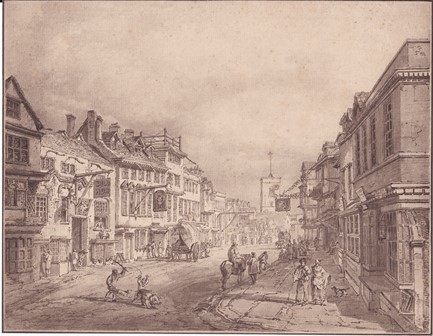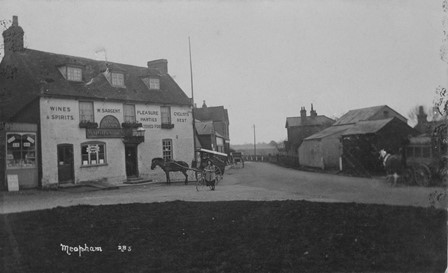Buses
At the last census only 1 in 10 households in Hartley did not own a car, so it perhaps not surprising that bus usage today is not high. In the 2005 Parish Plan, 17% of respondents said they used the bus at least once a month, although the response rate was lowest from the part of Hartley with the lowest levels of car ownership. In the 2011 census about 3% of workers commuted by bus to work, inferring that the majority of bus journeys are for non-work reasons.
Before the Motor Bus - the Village Carrier
Scheduled bus services in Hartley have been around less than a century. Before then people would have to make their own way to Dartford and Gravesend. The local councillor in the early 20th century, George Day, used to walk to council meetings in Dartford from North Ash Farm (even though as a prosperous farmer, he surely would have had a pony and trap). Those who did not own horses would have to walk to Dartford or Gravesend. With the coming of the railways many chose to walk to Longfield to catch the train to Gravesend.
Before buses the nearest equivalent was the local village carrier. Thomas Hardy's novel "The Woodlanders" begins with one such carrier wending its slow way to the market town. But the village carrier did far more than just transport passengers as this description shows:
“Perhaps it would be possible to picture a carrier’s day. If an early start was required, he had to be loaded up the night before with goods to sell, and his notebook would be full of items to be purchased in the market town for his village shopkeepers and housewives. New potatoes, butter, eggs, dressed poultry, flowers, chickens and geese, dead or alive, hampers of game and many more country products, plus several passengers.
These were mostly wives of local farmers and smallholders, who would take their produce with them to sell in the market place. There were also villagers, including children, visiting relatives, or just having an exciting day out in the busy towns, a day looked forward to for many weeks – many village folk could afford only rare trips to market, and a ride in the carrier’s cart was a red letter day indeed. The passengers sat on wooden frames, and the youngsters were frequently warned to ‘sit still and mind the eggs’.”
(W E B Hallgarth, “The Village Carrier”, Lincolnshire Life April/May 1963)
An early carrier - the Dartford Errand Cart (centre of picture) in 1794
The best source for carrier services is the county directories of the time, however many were omitted because they didn’t operate a scheduled service, the only local villages with an omnibus service to Dartford were Shoreham, Eynsford and in between. The earliest local carrier we know about was John Atkins of West Yoke, Ash, who combined it with his main profession of grocer at the time of the 1851 census.
Many carriers were women, as was the case with the next local we know about. In 1862 Sarah Roots, a 64 year old lady from Haven Hill, Ash used to drive to Dartford twice a week, accompanied by her dog. In her later years she lived in the Ash Almshouses. After Sarah it appears there was a time when there was no scheduled carrier service from our area. Interviewed in 1939 Mary Ann Packman of West Yoke (1856-1948) said while there were small shops in West Yoke and Fawkham, "but when new clothes or boots were wanted it meant a 9 mile walk to Dartford or Gravesend. Later there was a carrier who went to Gravesend once a week to fetch parcels and papers and who carried passengers also. The first of these was Mr Stephen Hills, and he drove a donkey and cart (listed in 1891 census as living in South Ash). His successor was a lady, Miss Brooks, who drove a horse and van. The fare was 1 shilling (5p) return, so that travel was not as expensive as one might imagine. Mrs Packman remembered how excited she would be as a child when her mother dressed her in her Sunday best preparatory to setting out on a journey to that most delightful of places, a town." (Norris Willatt, Dartford Chronicle 1939). The fare would be equivalent of about £4 in 2018 which compares well with the £6.50 return fare to Gravesend on the bus now.
The earliest carrier from Hartley we know about was Henry Outred, a market gardener, who travelled to Gravesend from Hartley on Tuesday, Thursday and Saturday from 1891 to 1901. He was succeeded by Thomas Whiffin of Whiffins Cottage in Church Road. In 1901 his horse bolted while in Queen Street and crashed into a barrowload of fish. They would have formed the “Numerous carrier’s carts, coaches and omnibuses, curiosities of a bygone age, slowly wend their way to the town centre one a week or more, from villages 20 miles away, although motor machines are slowly but surely driving them from the road.” (Alex Philip, ”Gravesend Corporation Guide”, 1908).
A Carrier's cart outside the Post Office at Maidstone
In 1913 the area had carriers to both Dartford and Gravesend. Tom Blake of Hartley Bottom left the Royal Oak for Dartford at 8.15am on Tuesday, Thursday and Saturday, calling at Hartley Green at 9am. While John Talbot of Haven Hill left Ash Street for Gravesend on the same days at 8.45am.
The last local carrier was Horace Lovell (1872-1955), farmer and carrier, who travelled to Gravesend on Tuesday, Thursday and Saturday from Stansted via Ash in 1922. Charles Ellerby remembers Mr Lovell, "fourpence (1½p) I think it was for the privilege of a hard seat and packed with live poultry, wire-netting and roofing felt, dead rabbits and sacks of potatoes. Or Mr Lovell would take your shopping list and bring back the goods - overall charge of one penny per shop (I think)"
Carriers found it hard to directly compete with the railways. Although not very successful, the line from Swanley to Gravesend certainly had an effect on local trade. In 1895 Dartford tradesmen said that since the railway opened in 1886 they had lost trade from Swanley, Eynsford, Shoreham and Farningham to Gravesend. The omnibus from Dartford to Farningham was shortened to Sutton at Hone as a result.
Some carriers called themselves "omnibuses" which is the name which has stuck. By 1857 omnibuses ran 5 times a day between Farningham and Dartford, and daily from Gravesend to Plaxtol via Meopham and Ightham. "The rather grand souding omnibus, however, should not deceive us into thinking these horse drawn vehicles were very different from the carriers' carts." (Alan Everitt, "Country Carriers in the 19th Century", 1985)
The Meopham Omnibus? Meopham Green in 1912, the cart with windows on the right could be the omnibus which started there at this time.
Buses
As the Gravesend Guide had said in 1908, that the horse drawn village carrier was being replaced with the motor bus. Hartley and Ash's turn came in 1922 when the Grey bus of Ronald Holland of the Railway Tavern, Longfield was launched (Dartford RDC minutes 9.5.1922). The Dartford Chronicle of 27 November 1931 noted that locals were happy his "Grey Bus" had overcome opposition, because they remember he ran a bus service from Hartley to Longfield when the bigger companies weren't interested. The service was limited to two daily round trips leaving the Black Lion at 9.15 am and 1.30pm and returning from Dartford at 12.30pm and 5pm , with a couple of other buses running on certain days of the week. On Tuesdays and Saturdays the bus ran from Ash White Swan. Fares to Dartford were 1/3 (6p) from Ash and 1/- (5p) from Hartley. Mr Wells Thatcher in the parish magazine (Sept 1925) said Mr Holland was a great favourite with passengers "but the chaff that flies about as he steers his way along the Ash Road makes it difficult for him to see ahead".
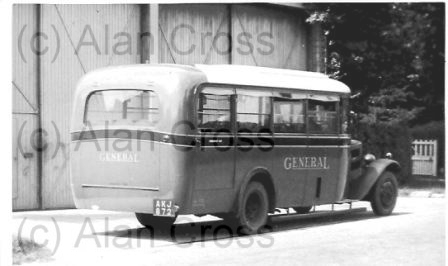
Holland Morris Viceroy Bus purchased in 1933, in LPTB livery used 1934-1938 (by kind permission of Alan Cross)
In 1925 competition came from Maidstone and District Buses who ran from Ash to Dartford (from 1 July 1925) and the Enterprise Bus which ran from Hartley Hill Cottage to Gravesend. The competition from Maidstone and District was not wholly popular, in 1929 Longfield Parish Council ordered the police to prevent M&D buses stopping at the station to pick up passengers for Hartley, but Dartford RDC told the police they had no right to do that and stopping competition was against the public interest. All local services were taken over by the London Passenger Transport Board in 1934. They came to an agreement with Maidstone Bus which Gravesend services each should run. Initially this was not popular because the Longfield - Hartley fare rose from 2d to 3d (Dartford Chronicle 26.1.1934). The fare to Gravesend was 11d (5p).
About the same time as the first buses appeared the first taxis in Hartley. Based on adverts in the parish magazine, these were Frederick Chuter of Little Downs, Ash Road (1926), R C Whitmore of Gossy Croft, Hartley Hill (1927) and W Alexander of Cavan, Church Road (1932).
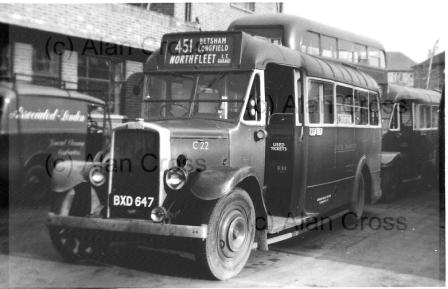
451 Bus from Hartley to Gravesend in about 1950 (by kind permission of Alan Cross)
LPTB introduced the route numbers we are familiar with today - the 423 (then from Longfield to Dartford) and the 489 from Gravesend to Ash and the 490A from Gravesend to Hartley Court - see September 1936 timetable and 1954 timetable.
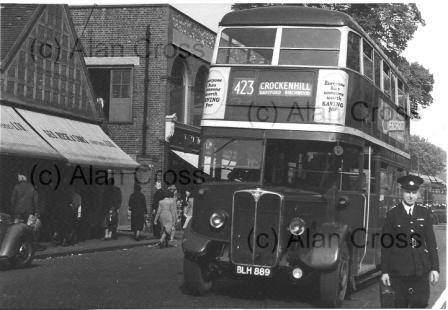
423 bus in 1950 (by kind permission of Alan Cross)
Reorganisation in 1970 led to a new name appearing - London Country Buses, a subdivision of the National Bus Company. In the 1980s the government broke up the National Bus Company; London Country South East which had become Kentish Bus in April 1987, and was sold to the British Bus Company on 15 March 1988 ([link:2]further info[/link:2]). British Bus was bought by Arriva (then called the Cowie Group) in 1996, who continue to operate most of the buses locally today.
The deregulation of the 1980s also allowed other operators to launch bus services. For a while Transcity Link of Sidcup ran buses on the 423 route, while in 1993 Red and Green coaches of Chislehurst ran a commuter bus (route 301) from Longfield to New Ash Green. Another company was Thames Weald (see article) of West Kingsdown, who most ran services from Dartford to Essex, but also ran a school service from Hartley to Sevenoaks, and after deregulation they branched out into running additional evening commuter buses from Longfield to (as I recall) Hartley Social Club.
The routes themselves have undergone alterations over the years. For a short while the 423 and 489 were renumbered the 16 and 10 respectively. There have been experiments in routing the 489 via the Sainsburys in Pepper Hill and Waterdales in Northfleet, but it now runs on more or less its classic route. The 423 has undergone drastic changes, and now takes a most roundabout route to Dartford, via the Darent Valley Hospital, Bluewater and then via the Fleet Estate and Park Road. It now takes 50 minutes to get to Dartford, which is 6 miles by the shortest road route.
423 Bus at Woodland Avenue, 2016
Fares have risen dramatically in recent years. This fare table dated 1970 for the 489 bus, shows the fare then from Hartley to Longfield was 7d (3p) and from Hartley to Gravesend it was 2/5 (12p). Now the same journeys will cost £2.40 and £3.90 respectively. It is clear bus passengers have fared much worse than drivers over the years. In 1970 a gallon of petrol was 33p, now it is £6.04 (source: AA Motoring Trust). This means petrol has gone up 18 fold since 1970 but the bus fare to Gravesend has gone up 33 times in the same period.

